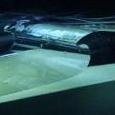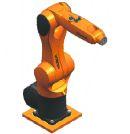Search the Community
Showing results for tags 'control logix compact logix'.
Found 153 results
-
Hello admin, Im new to PLC domain , i have one OMRON CP1E N30 with in built RS 232 port and ladder program to run in Homing and forward and reverse motion. I want to control the PLC from a computer using RS 232 communication. From what little i read from manual supplied for programming ,i came to know that there are two type of commands C mode as well as Fins commands. My doubt is whether these commands can read/write CIO memory addresses that are used to set and reset the motor enable/disable in ladder program through CX programmer software? for example: in my ladder program CIO memory address 30.00 is the motor enable/disable address so if i want to control externally from a PC to enable/disable the motor ,which commands should i use and is there a format to send these commands as well as the value. I am planning to build a GUI in Labview to cotrol the PLC via Serial RS 232 . How can i do it ? Thanks in advance.
- 2 replies
-
- cp1e
- hostlink control
-
(and 5 more)
Tagged with:
-
Hi everyone! I am currently using both Motion controller Q172DSCPU and Simple motion controller QD77MS for my application. I spent time for Advance synchronous control with Motion controller QD172DSCPU. However, I wonder that is there any solution to combine synchronous control and interpolation control? For example, I need controlling 4 axes consisting of 3 axes for helical interpolation and 1 axis for linear position control. The problem is that all 4 axes start and complete position at the same time. Does anybody have experience in this? please share your ideas. Thanks in advanced.
-
I am a technician at a large repair facility and we often have Beckhoff control panel displays come in for repair. I'm having trouble using Twincat to set up the buttons on a CPxx to test the buttons and assignable leds. We have a PC running windows XP with the twincat software, a CP9035 pci card to connect the CP to the pc, i can see the PC's display on the CP and also recognize the CP in twincat, just unsure how to map testable functions to the keys on the CP. Hope this all makes sense. Hopefully there is a Twincat guru out there that knows how to do this. Thank you!!
-
Hello everyone, I have a quick question regarding Din rails, chassis ground and ground loops. Here is where I am getting confused. I connect my back panel to earth ground which, connects my control panel chassis to earth ground. I screw din rails on my back panel. Question #1: logically, my din rails are now connected to earth ground through the screws connecting to din rails to the back panel. Am I wrong here? As I have seen in many control panels, I connect a ground terminal block to my din rail and connect it to earth ground (the terminal block couples with the din rail through metal clamps). I now use that ground terminal block as a single point source to ground all my other components in the control panel (I connect my ground terminal block to earth ground using a wire).. *** the ten thousand dollar question is Didnt I just create a ground loop between my ground terminal block mounted on the din rail and my back panel chassis ground. For one reason or another the two different location might be at slightly different potentials causing current to flow. Where is my logic off here???? Thank you
-
Hi, I'm a long time lurker and would like to start by saying thanks for all the help over the years, much appreciated! This is my first post, please be gentle. I'm working through a large project with an L83 (V28) including 75 EIP nodes & 5 servos. We have a need for quick real-time response of 2 cameras during a quick servo move (taking several pictures). I've broken my program up into a few event driven tasks (allowing me to chose the execution time interval (5 to 8 ms for more important tasks and 20 ms for less important tasks, etc.)), along with these I have 2 periodic tasks: 1 for my HMIs & faults running every 30ms and 1 for this quick real-time response camera situation running at .5ms which contains my camera and servo logic. Everything is running well and seems responsive and repeatable enough, but I am now adding the second half of the logic which will essentially double everything (2 up system). This has made me consider the best structure approach: Is it better to have a few larger routines within a few larger tasks or better to have more smaller tasks containing an abundance of smaller routines or some other different mix? Thanks, JD43
-
- allen bradley
- ab
-
(and 5 more)
Tagged with:
-

Run time free production .NET AB Logix library
Mandeep Ahuja posted a topic in Allen Bradley / Rockwell Automation
Hello guys, Newbie on this site. I am looking for a run time free Allen Bradley .NET driver. Basically a library (.dll) that implements communication protocols to Allen Bradley PLC's ( CIP, Ethernet/IP, etc.). Can someone point me in the right direction please ?.- 1 reply
-
- allen bradley
- ab
-
(and 4 more)
Tagged with:
-
-
- kuka
- krc4 compact
-
(and 3 more)
Tagged with:
-
KUKA: Agilus View File KUKA: Agilus six axis Submitter panic mode Submitted 02/16/17 Category Robots and Servos
-
- kuka
- krc4 compact
-
(and 3 more)
Tagged with:
-

A simple tutorial .smc2 project program for motion control (1) G5 servo
lamboom posted a topic in NJ Series / Sysmac Studio
hI.. I've asked for this in the past and, so far, haven't been very lucky. Most of the projects I run into have 4 or 5 axis, lots of analog and sensor input.. or don't have the HMI part of the "Machine" I have a nice NJ 101-1000 with the NA 7 inch HMI.. along with a R88BD-KNA5L-ECT servo and a 50W G5 motor.. type R88M-K05030H-S2. All On a nice rack with power supplies and some EtherCAT I/O (It all functions .. even "MC Test Run" gets the motor to jog .. But.. no way to "home" it.... The motor is in "rotary mode" but... it's NOT got an Absolute encoder.. it's a incremental... sniff! I just want it to stop on zero ..Or anywhere, and call it zero ... and make moves plus an' minus in degrees, that's all.... I assume I have to send it some signal (push button) while it's spinning that tells it it's in "Proximity" to home and it then it does something which makes it end up on zero. I've homed a lot of linear motors (LinMot) an' they are very easy to work with. But, Omron has 10 different homing modes .. and they aren't very well explained. Well, they aren't explained at all in that 502 page user manual... you have to already know how to do it, in order to understand the explanation... Example: Take the "Home Proximity Input Signal" .. I can imagine what it might do, to help control a move to home. I can even imagine what's making the signal .. and that somewhere there is a place where the homing parameters are set... like the "axis setting table" .. but, it's not a Global Variable, or a Data Type .. I could imagine it gets into the system from the CN1 I/O connector? or some I/O somewhere? But.. I grow weary of imagining how this system actually works.. Building a simple working project, from a tutorial, or even downloading a simple working project (.smc2 file) and making the minor adjustments to fit my equipment ... would make all the difference in the world. I've searched Omron's Libraries of .smc2 files. Haven't found any yet that aren't on the level of "Top Gun" (a seriously complicated project for a 1-week training class) ... Oh there are several.. related to IAG object files .. but those Library files are not "working projects" intended to serve as a Tutorial.. they are limited projects, ready to be configured with IAG Object files, and "your" programming ... So that you can write the programs you need "faster"... which is nice... but, no help here. Somewhere out there.. is a nice simple .smc2 project file where you get to control a simple motor from the HMI ..Preferably using an NJ CPU and a NA HMI .. home the motor.. jog the motor and input a few "go-to" positions... sigh!.. Like you would do in a One or Two Day class... This kind of thing should be already be available in the Sysmac Library ... Thanks much for listening.. sorry about the rant. -
hello everyone, Im new with schneider electic , ı m planing to work with Altivar 630 variable speed drivers and i want to control it with M241 plc in somachine . but when i want to configure in somachine i could not add the driver to my hardware. is there any document about it ? or does anybody control it like this ?
-
Omron PLC-HOW TO connect and control I/O throug
-
Hello to everybody! This time I need to make a program to control temperature ... Some help? I don't know how to use an analog module, I'm just starting to working with them. The PLC I have a FX3u-32MR/ES (Mitsubishi), and I have the modules; FX3u-4AD-ADP and FX3u-4AD-PT-ADP for temperature measurement. PLEASE HELP? Have a good day!
- 2 replies
-
- temperature
- control
-
(and 2 more)
Tagged with:
-
i need a example code for position control of MR-J3-20A with QD75D4 as intelligence module. and i want to see the parameter if possible
-
EMS provides low cost analog sensors useful for PLC analog inputs. For example the $25 temperature sensor (+/- 2%) is a useful and inexpensive way to monitor for an over temperature condition in a panel cabinet. emssensors.com AC voltage and current transmitters can be a useful way to monitor motor performance. Even the sound level sensor can be a good way to generate an alarm condition for a bearing failure.
-

Unable to load non compact machine edition application
Robert Alan Andersen posted a topic in Allen Bradley / Rockwell Automation
I get this error even if the application is compact edition. Plz halp -

Code compliance Re migration from PLC5 to Control logix 500
MAbbasi posted a topic in Allen Bradley / Rockwell Automation
We are replacing the Old hardware from PLC to new Control logix hardware. wondering Application of IEC-61508 and IEC-61511 compliance in this brown field project. Any Thoughts ?? -
We have a Panelview Plus 600. One of our panels is labeled "Motor Control," in charge of turning on/off different pumps. The problem is while the system is running, clicking the on/off button will not turn any pump off. When the system is shut down, the pumps can be turned on and off but not when the system is running. I'm trying to shut off one pump without shutting the whole line down. Any help is appreciated. Thanks.
- 1 reply
-
- pushbutton
- motor control
-
(and 1 more)
Tagged with:
-
Hi! I just started with PLC programming. I am trying to get the time between a output signal and a input signal. The problem is that the time is ~200 ms but when i measure it with this code: TONR(Timer1); IF PosFeedback <= PosFeedback_Min & not Timer1.Reset THEN Timer1.TimerEnable := 0; FullCloseDeltaTime[1] := Timer1.ACC; Timer1.Reset := 1; END_IF; IF (move & not Move_LastScan) THEN //Start timer Timer1.TimerEnable := 1; Timer1.Reset := 0; END_IF; Move_LastScan := move; i only get even values in intervalls of 50 ms like 150, 200 and 250 ms. I have changed the real time sample rate to 11 ms so i don't understand why i don't get a more exact result. And i can see in my trend that the time isn't exactly 150, 200 or 250 each time. I i tried and time my own click on a button and i see the problem is the timer, i only get values in an interval of 50 ms. Is there a way to make the timer more exact?
- 4 replies
-
- allen bradley
- logix designer
-
(and 2 more)
Tagged with:
-
We have a Panelview Plus 600. One of our panels is labeled "Motor Control," in charge of turning on/off different pumps. The problem is while the system is running, clicking the on/off button will not turn any pump off. When the system is shut down, the pumps can be turned on and off but not when the system is running. I'm trying to shut off one pump without shutting the whole line down. Any help is appreciated. Thanks.
- 5 replies
-
- pushbutton
- motor control
-
(and 1 more)
Tagged with:
-
Which type of electrical panel is most reliable, give some idea about that ..?
- 1 reply
-
- electrical control panel
- lt panel
- (and 3 more)
-
I just need to understand a little bit more about the PCS7 architecture, if someone could point me to a document or a video or something, or just give me a few sentences to break it down it would be greatly appreciated. The reason being, we have a quote that we are working on for a customer over seas and are being told to quote our equipment with an S7-410 PLC. I am very unfamiliar with Siemens in general, but completely unfamiliar with the PCS7. Our equipment is typically if not almost always stand alone equipment that communicates discretely to the rest of the facility. Our equipment is not part of a process line, but rather feeds the process line equipment what it needs to perform its operation. I have been led to believe that the S7-410 PLC must be part of a DCS, so it does not seem like the correct fit for our equipment. I just want to confirm this and learn a little bit more so I can explain to our sales folks and ultimately the end user why it is the wrong option for us and our type of equipment. Thank you!!! Heather
-
Hi Everyone, I have a PowerFlex 525, in Velocity Mode with a Encoder Card "25-ENC-1". We are controlling this drive via TCP/IP with a 1769-L32. Through the PLC if I try to toggle the Bit for "Pos Redefine" in A560 [Enh Control Word] it instantly turns back to 0. But through the Parameter List Editor I am able to toggle A560. For My function I need to have the drive in Velocity Mode, If I change the drive to Position Mode I am able to toggle "Pos Redefine" Any Thoughts would be great
-

Disable BOOTP on built in ethernet port
GeraldTech posted a topic in Allen Bradley / Rockwell Automation
It's another BOOTP post! I know you're all as excited as I am, so lets get started. But seriously, I'm trying to disable BOOTP on the built in Ethernet ports, not on an Ethernet module. I specifically say disable because BOOTP successfully assigns the IP address to my Compact Logix, however I still need to disable BOOTP to make it a static IP address rather than a dynamic IP address. I'm going to list everything that I have tried, so that anyone with the same issue can have an all-in-one-place reference. (Because there's a number of forum posts and other information for this topic on the internet, with many different suggestions) If I see different ideas/suggestions in other places, I can edit them into this post. Things I have tried: (and you should try if you have this issue) Disabling all firewalls, (For me: Windows/Avast) Disabling all other network adaptors. (Wifi especially, but any and all adaptors you are not using for the setup) Using a different laptop/operating system: (My current laptop runs windows 8.1 and uses a Linksys usb to Ethernet device to talk to the PLC, I tried a laptop running windows 7 which communicated using a built in Ethernet port) Lastly: Try to use all available methods to disable it. For me, that would be: BOOTP standalone server, RSLinx, (Trying to use both USB and Ethernet connections) and finally RSLogix. (Actually, only Ethernet modules have a "disable BOOTP" checkbox built into RSLogix, so that is not an option for me.) [If you have an Ethernet module, go to port configuration in RSLogix and uncheck the "enable BOOTP" checkbox] Anyway, RSLinx Classic (version 3.71) and BOOTP Standalone server (version 2.32) are each coming back with an error when I try to disable BOOTP. I'll attach a .jpg of some screenshots, and some Wireshark save files to show what I mean. In the RSLinx Wireshark file, it shows a "privilege violation" packet being sent from the PLC to the laptop towards the end of the exchange, but I'm not sure what privileges the laptop needs/doesn't have. For the wireshark files: I cleared everything happening before I try to send the command, so that there isn't a ton to search through. As far as timing of the wireshark files go: I start recording traffic, send the disable command (by clicking the disable BOOTP/DHCP button on BOOTP server or "apply" on RSLinx) then I stop recording traffic once I get the error message. So, the captured packets should be just the attempt to disable BOOTP and that's about it. I am sorry that I the pictures are strung together using paint, but I don't have photoshop on my work computer so it's the best I have. Any suggestions/help would be appreciated! (Regardless of whether they are suggestions for me, or suggestions that I may have missed intended for anyone with this problem.) Thank you for your time. Edit: I had the attached pictures open in paint/photo viewer, sorry that they look bad in the forum picture viewer. BOOTP_wireshark.pcapng rs_linx_USB_wireshark.pcapng rs_linx_wireshark.pcapng- 10 replies
-
- bootp
- bootstrap protocol
-
(and 3 more)
Tagged with:
-
Hi guys, been using this site for a long time, it has come in handy alot. However I have recently taken on my first servo project, heres an overview of the project We have a filling machine that has a separate dosing system to the filler head. It used to keep the dosing in time by adjusting a 0-10v signal to an inverter to make sure that a flag makes a sensor in a set window. I have installed an encoder on the filling head and an mpl servo to the dosing. I have then used an MAPC instruction to follow the encoder, the cam is 0-360 and it follows a straight linear line. I have installed of this as a temporary set up on one of the filling machines (we have 2) and it is working perfectly. I have now installed this on the second machine as a permanent set up with a panelview plus 7, L71 cpu. However it is giving a very strange problem on first power up, the encoder is giving the exact same position as before it was powered down. however as soon as the MAPC executes the servo axis faults, giving an overspeed fault. the servo doesnt even look like its attempting to move (however it is through a 10-1 gearbox). if i then home the encoder it then runs absolutely perfectly until it is powered down again. I am beginning to think it may be to do with the master lock and cam lock position, as the cycle stop position of the two machines are different. however I just cant seem to get my head around i the difference between them. Hopefully that makes sense any help would be greatly appreciated Thanks Rhys c1_dosing.ACD
-
Hi, Is there any setup to manage alarms in one PLC from multiple CX-Supervisor runtimes running on different computers? If I get an alarm, it shows up on both runtimes. If I acknowledge from one runtime, I also want it to be gone from the list in the other runtimes.
-
- cx-supervisor
- multiple
-
(and 3 more)
Tagged with:




